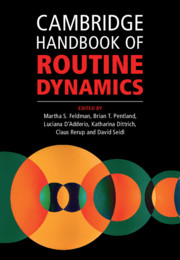Book contents
- Cambridge Handbook of Routine Dynamics
- Cambridge Handbook of Routine Dynamics
- Copyright page
- Contents
- Figures
- Tables
- Contributors
- Preface
- Chapter 1 What Is Routine Dynamics?
- Part I Theoretical Resources for Routine Dynamics Research
- Part II Methodological Issues in Routine Dynamics Research
- Part III Themes in Routine Dynamics Research
- Part IV Related Communities of Thought
- Chapter 33 Carnegie School Experiential Learning and Routine Dynamics
- Chapter 34 Dynamic Capabilities and Routine Dynamics
- Chapter 35 Strategy as Practice and Routine Dynamics
- Chapter 36 Path Dependence and Routine Dynamics
- Chapter 37 Business Process Management and Routine Dynamics
- Author Index
- Subject Index
- References
Chapter 34 - Dynamic Capabilities and Routine Dynamics
from Part IV - Related Communities of Thought
Published online by Cambridge University Press: 11 December 2021
- Cambridge Handbook of Routine Dynamics
- Cambridge Handbook of Routine Dynamics
- Copyright page
- Contents
- Figures
- Tables
- Contributors
- Preface
- Chapter 1 What Is Routine Dynamics?
- Part I Theoretical Resources for Routine Dynamics Research
- Part II Methodological Issues in Routine Dynamics Research
- Part III Themes in Routine Dynamics Research
- Part IV Related Communities of Thought
- Chapter 33 Carnegie School Experiential Learning and Routine Dynamics
- Chapter 34 Dynamic Capabilities and Routine Dynamics
- Chapter 35 Strategy as Practice and Routine Dynamics
- Chapter 36 Path Dependence and Routine Dynamics
- Chapter 37 Business Process Management and Routine Dynamics
- Author Index
- Subject Index
- References
Summary
In the strategic management tradition, dynamic capabilities are interpreted as grounded in high-level routines, while in the routine dynamics framework routines are seen as inherently dynamic. Despite the apparent convergence of constructs and interests, these two approaches to understanding routines and the dynamism that they embody and engender have not been building on each other. In this chapter I analyse commonalities and differences between the two views in relation to their ontologies, their focal interests, and their levels of theory, measurement and analysis. I also describe how the two views contribute—although from different angles—to answering the same questions on routines emergence and change, on their role in inhibiting and promoting creativity and novelty, and in maintaining pattern and variety. Finally, I provide directions for future research on routine participants, ecologies of routines, and routines performance, which build on both views, without necessarily integrating them.
Keywords
- Type
- Chapter
- Information
- Cambridge Handbook of Routine Dynamics , pp. 460 - 480Publisher: Cambridge University PressPrint publication year: 2021
References
- 7
- Cited by



